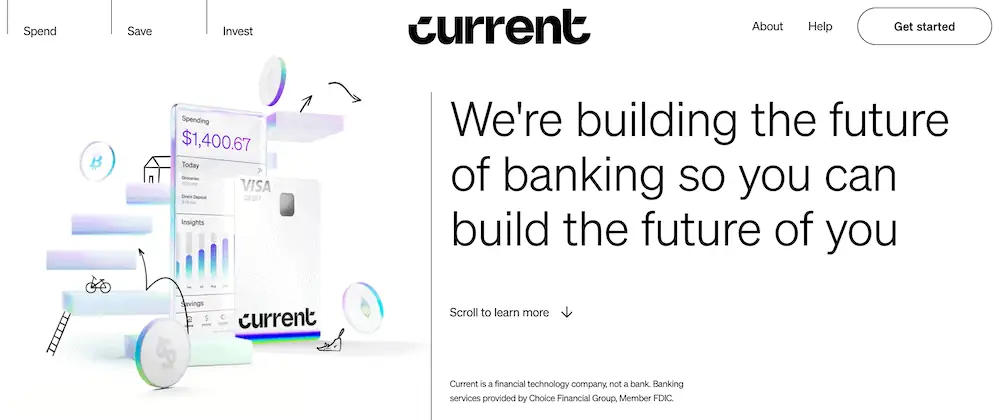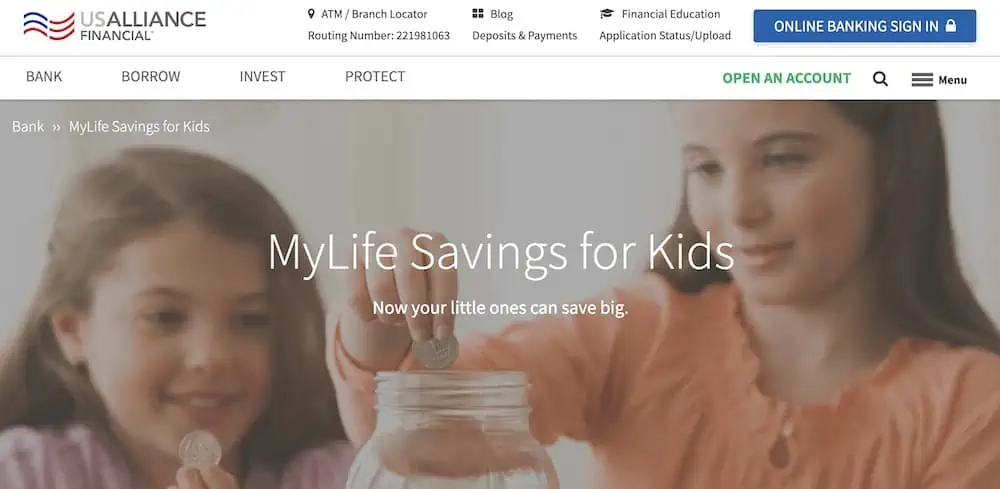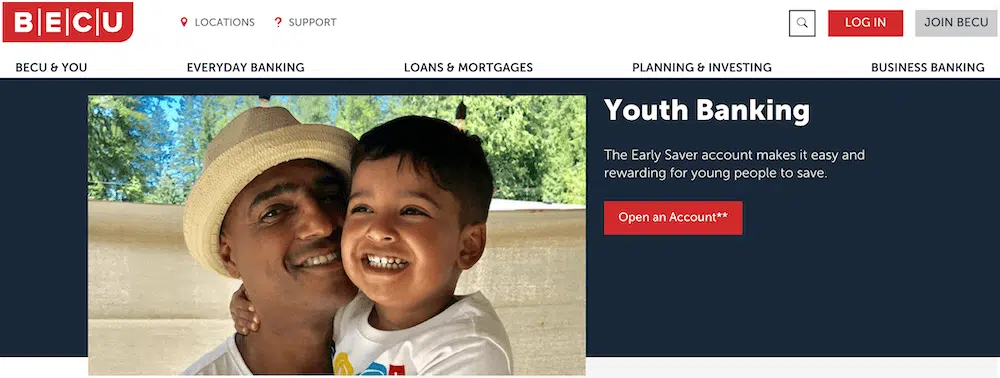It’s never too early to teach your children healthy spending and saving habits. Opening a savings account for kids is often one of the very first ways parents start their kids on this journey.
For the record: Adults can always just head down to a local credit union or bank and open a standard savings account in their child’s name. Any kid will benefit from having their own savings account, basic or otherwise.
But by opening up a dedicated kids savings account, parents and their children can enjoy many of the excellent features that come from products specifically designed for youths.
Read on as we explore today’s best savings accounts for children. Each section will detail what sets the bank, credit union, or online financial institution’s account apart from the competition. We’ll also teach you to be a smarter account consumer by discussing the important features of kid savings accounts and answering other commonly asked questions (FAQs) about savings accounts for children.
Let’s dig in!
Best Savings Accounts for Kids—Our Top Picks
|
Primary Rating:
4.8
|
Primary Rating:
4.3
|
Primary Rating:
3.6
|
|
Core: $5.99/mo. Max: $9.98/mo. Infinity: $14.98/mo. (Each account supports up to 5 children.)
|
No monthly fees.
|
Free (no monthly fees).
|
Best Savings Accounts for Kids
1. Greenlight (Great Savings Rewards + Cash-Back Rates)

- Available: Sign up here
Greenlight, while technically not a savings account, is a family-designed debit card with so many savings features, it trumps many traditional savings products. That includes the ability to earn as much as 5% rewards on savings.
Children can set Savings Goals for specific purposes, whether that’s a new gaming system or college tuition. Then every month, Greenlight calculates your kid’s average daily savings balance, multiplies it by the percent earned annually, and divides it by 12 months to get the monthly reward amount. That amount is deposited proportionally into General Savings as well as any active Savings Goals.
The monthly rewards you can receive on those savings depends on your plan: Greenlight Core families earn 2% per annum, Greenlight Max families earn 3% per annum, and Greenlight Infinity families earn 5% per annum on an average daily savings balance of up to $5,000 per family.
Also, those in Greenlight Max and Infinity families can earn 1% cash back on their monthly spending with the kid’s debit card.
Children also can speed up their savings with Round Ups; purchases are rounded up to the next dollar, and the difference is automatically added to their savings.
Want to help your children save more? Parents can set a percentage of allowance to go straight into savings. The allowance can be directly deposited on a schedule or tied to chore completion. Greenlight also offers “Parent-Paid Interest,” where a parent can set an interest rate of anywhere between 1% and 100%, then pay that into the account based on their childrens’ savings. This not only encourages children to save, but also teaches the power of compound interest.
Greenlight also boasts a number of other features for kids and parents alike. For instance, kids will benefit from educational materials, while teens will enjoy direct deposit if they have a job. Parents, meanwhile, enjoy controls such as extremely customizable spending limits—they can let children spend wherever they want, only at certain types of retailers, or even set exact dollar amounts only to be spent at specific stores. You can learn more about Greenlight or sign up here.
- Greenlight is a financial solution for kids that allows them to spend with a debit card, earn money on savings, and even invest their money.
- Greenlight offers flexible parental controls for each child and real-time notifications of each transaction. And it's the only debit card that lets you choose the exact stores where kids can spend on the card.
- Parents can use this app to teach kids how to invest with a brokerage account through Greenlight Max and Greenlight Infinity plans.
- Families can earn 2% (Core), 3% (Max) or 5% (Infinity) per annum on their average daily savings balance of up to $5,000 per family. Also, Max and Infinity families can earn 1% cash back on their monthly expenditures.
- Unlike many apps that simply provide features and controls, Greenlight is also designed to spark discussions with children about spending, investing, and more, fostering a better educational experience.
- Best-in-class parental controls (can prohibit specific stores)
- Can add brokerage account to invest in stocks
- Intuitive Parent + Kid apps
- Competitive cash back & interest rates
- Parent-Paid Interest
- High price points
- No cash reload options
- No parent / child lending
Related: 11 Best Prepaid Debit Cards for Teens & Kids [Reloadable]
2. Cash App Families (Cash App’s Debit Card for Teens)
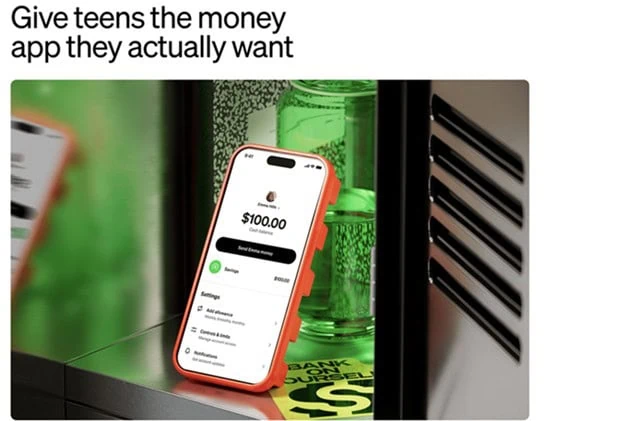
- Available: Sign up here
Does your teen need to start learning smart saving, spending, and even investing habits? Cash App Families can accomplish all three—with no monthly fees—putting the power of Cash App into your teen’s hands while keeping their financial safety firmly in yours.
Teens get an account with a designable Cash App Visa debit card, which they can use to spend money where Visa is accepted. Meanwhile, access to Cash App allows them to save money toward specific goals, send money to friends, accept offers for instant discounts at their favorite places, and check out securely in stores and online by using a QR code.
If your teen direct-deposits $300 or more each month, they’ll also unlock a bevy of other features, including getting paid two days earlier, no ATM fees¹ when withdrawing from more than 40,000 in-network ATMs, and one waived out-of-network ATM withdrawal per month.
Cash App Families even has an investing feature with fractional shares, allowing kids to purchase as little as $1’s worth of stocks and Bitcoin (parent permission is required).²
Meanwhile, parents/guardians who sponsor the teen** enjoy some of the best oversight features among teen debit cards. You can monitor your teen’s activity from your own Cash App or receive real-time transaction alerts for their payments and purchases. You control which features—stocks, Bitcoin², sending money, the Cash App Card—your teen can access, and certain spending categories are auto-blocked for teens. can also send money for allowance whenever they want, and built-in tools allow parents and teens to budget and save together.
Parents/guardians must download Cash App (also free), then invite their teen to create a sponsored account. Cash App Families can be used by teens ages 13-17. Use our link to learn more about or sign up with Cash App today.
- Cash App Families is a banking app and debit card that helps teens ages 13-17** learn about, spend, save, and invest money while under the protection of a large suite of parental oversight tools.
- Teens get a customizable Cash App Visa debit card*, can make and receive instant person-to-person payments, can fund their account with direct deposit, and can even buy as little as $1's worth of stocks and Bitcoin.²
- Your teen can earn 3.25% interest on their savings. No fees and no account minimums.³
- Pay your kids an allowance, and use Cash App's tools to save and budget together.
- Safety features such as real-time transaction alerts, account monitoring (from the parent's Cash App), alerts for teen payments to new contacts, contact blocking, feature control, payments control. Also, Cash App auto-blocks certain spending categories to teens, and strangers can't find teens in Cash App search.
- Features such as two-day early payment, free in-network ATM withdrawals, and a monthly reimbursement for an out-of-network ATM withdrawal are unlocked when $300+ is direct-deposited each month.¹
- Free account and Visa debit card*
- Excellent parental controls (including feature lock and real-time transaction alerts)
- Stock and Bitcoin investing²
- Fractional shares²
- Customizable cards ($5+)
- FDIC insurance available on a pass-through basis (if certain conditions are met)***
- Certain benefits, such as free in-network ATM withdrawals¹, require direct deposit of at least $300 monthly
- Parents can give money, but no dedicated allowance features
3. Capital One Kids Savings Account (National Bank Savings Account)
- Available: Click “Open Account” below
If you’re looking for a traditional experience, the Capital One Kids Savings Account is one of the best accounts available nationwide.
The Capital One Kids Savings Account requires no minimum balance to open, charges no monthly service fee, and can be opened at any age. Just note that if the child is younger than age 12, the adult has to be a parent or guardian.
It’s simple to link a parent’s bank account (and doesn’t have to be Capital One!) to a Kids Savings Account and send automatic deposits. Young adults old enough to have a job, or kids who receive checks as gifts from family members, can make mobile deposits with photos of their checks.
APYs are always subject to change. However, Capital One consistently maintains a high APY to help children earn more, and the current APY on the Kids Savings Account is higher than the national savings average.
While many other top savings accounts for kids are online-only, Capital One is one of the few nationwide providers that offers physical branches.
When children become adults, their Kids Savings Account automatically changes into a 360 Savings account.
Related: 7 Best Teen Checking Accounts [Bank Accounts for Teenagers]
4. Axos Bank First Checking: Best Free Teen Checking Account w/Interest
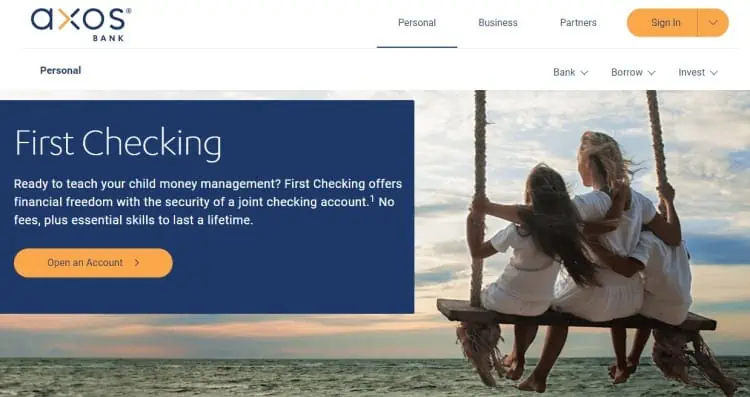
- Available: Sign up here
- Price: Free
First Checking by Axos Bank is the ultimate starter checking account for teens, which comes with a debit card. The banking world can be a little scary, but not with the simplicity and power of Axos’ First Checking Account.
The account works as a joint account between a parent or legal guardian and their teen, allowing for easy-to-set, customizable parental controls with a dashboard.
Parents and teens can manage almost every part of the banking experience through a convenient mobile app or through the online desktop portal—perfect for modern families who constantly find themselves on the go.
The First Checking account from Axos Bank gives teens their first taste of financial independence by giving them their checking account (which pays interest!) and free debit card for teens that has daily cash withdrawals limits of $100 and purchase limits of $500.
This provides safeguards against teens getting carried away with the money held in their accounts.
Further, you can have up to $12 of domestic ATM fee reimbursements per month, avoid any monthly maintenance, overdraft or non-sufficient funds fees—essentially making the account free!
The account carries the highest level of security through biometric authentication techniques like fingerprint readers, voiceprints and facial recognition (pending smartphone feature availability).
The product has a minimum age requirement of 13 and will convert to an Axos Checking Account after reaching the age of majority.
Axos Bank is a Member FDIC.
Read more in our Axos First Checking Account review.
- Axos Bank First Checking is a joint checking account targeted for teenagers ages 13-17 and their parents.
- Account holders get a Visa or Mastercard debit card that can be used to spend online or in person, or to withdraw cash at any ATM. (Axos provides up to $12 in monthly domestic ATM fee reimbursements.)
- No monthly maintenance, overdraft, or non-sufficient fund fees.
- The debit card's security features include account alerts, card locking, and daily transaction alerts of $100 (cash) and $500 (debit).
- Currently, you can earn up to 0.10% APY on any balance.
- Free (no monthly maintenance fees)
- ATM fee reimbursements (up to $12 per month)
- Converts to adult checking account after minor reaches age of majority
- No paired investment account
- No robust financial literacy resources
Related: Investment Accounts for Kids
5. Revolut <18 (Most Enticing to Children & Teens)
- Available: Sign up here
Revolut <18 is a prepaid debit card for kids designed to teach them money skills for life. Aimed at building healthy money habits from an early age, the unique, customizable card¹ empowers parents to have full insight into their kids’ card activity through providing instant spending alerts and parental controls.
You can choose to freeze the card, as well as set controls on how they use the cards online and with contactless payments through your Revolut app. You can also set spending limits on how much your child can use with the prepaid card.
Parents use the card and accompanying app to teach kids about earning, budgeting, saving and even investing money (depending on the plan chosen). You can also use the card to manage chores and allowance, set savings goals as a family, and help your children manage their money.
And if your child did something deserving of a reward? You can send parent-paid bonuses when they complete specific tasks. Simply add money to their digitized piggy bank through the app. You can send and receive money in seconds through Revolut’s payments feature, which allows fast transfers between account holders and also global transfers at transparent rates.
You must have a personal Revolut account before you can open a Revolut <18 account for your children. You can add up to five Revolut <18 accounts per parent account.
To learn more about Revolut <18, visit their site and open an account for yourself and your child.
- Revolut <18 is a prepaid debit card for kids designed to assist parents teach kids ages 6-17 about money. Families can handle chores and allowance, create budgets, set parental controls and more.
- Revolut <18 comes with unique, customizable cards* that parents can use to set up tasks and goals to work on together as a family.
- Prepaid debit card for teens
- Parental controls
- Round-ups
- Chore and allowance management
- Customizable designs (fees apply)
- Children can't load funds, only parents can
- Parents need to have a personal Revolut account
Related: Best Debit Cards for Teens
6. Current (Best for Transferring to Adulthood)
- Available: Sign up here
Current is a financial app designed for families that charges no monthly fees. It offers both Current Accounts (parents) and Teen Accounts, with the latter acting like prepaid debit cards that parents load for their children. Still, while it acts like a checking account/debit card in some ways, the Current app has a number of features that make it seem like a high-powered savings account, too.
Current Account users get three virtual Savings Pods, which can hold up to $2,000 each and have no restrictions on how often money is moved in and out of the Pod. Each Teen Account also gets a virtual Savings Pod. At the moment, Savings Pods earn an annual percentage yield (APY) of up to 4.00%, which is higher than even top high-yield savings accounts. Payments are applied to the balance daily. (Just note that bank interest rates change, so you should always confirm account yields before signing up. Also, Teen Accounts do not earn an APY on Savings Pods.)
Another savings feature: Account holders can use Round-Ups to round purchases to the nearest dollar amount, then store the difference in Savings Pods.
Other noteworthy Current features include:
- Track your teen’s spending in real-time, set limits on how much your children can spend, and even block specific merchants on Current’s Visa-enabled debit cards.
- Get paid up to two days early when you enroll in direct deposit. (Current Accounts only.)
- No minimum required balances, no fees on transfers to other Current and Teen Accounts, and no hidden fees.
- Earn up to 15x points, which can be redeemed for cash, when you swipe with more than 14,000 participating merchants. (Current Accounts only.)
- Giving Pods that allow your children to donate to charities of their choice.
- Withdraw money fee-free from more than 40,000 Allpoint ATMs across the country.
- Buy and sell 27 different cryptocurrencies with zero trading fees.
Teens will love easy allowance deposits, a card they can use in stores or online, and instant gas hold removals when buying gas. They’ll also have the opportunity to learn about financial responsibility and financial independence through Current’s Budgets feature, which allows them to track their spending and even receive alerts when they get too close to (or exceed) a predetermined limit.
This mobile banking app has no specifically stated minimum age requirement, but the marketing suggests teens are the target audience. However, you might be able to open an account for a younger child.
Once they’ve reached adulthood, your children can enjoy many of the same perks with a standard Current Account.
- Current is a financial technology platform that lets teens enjoy not just traditional banking basics, but numerous features meant to simplify spending, streamline saving, and set them on the path toward more organized finances.
- Teens can spend with the Current Visa debit card, which allows them to purchase in-store and online, as well as withdraw money fee-free from more than 40,000 in-network Allpoint ATMs.
- Current Teen Accounts also come with Savings Pods, which earn 0.25% APY and allow you to round up purchases (overages are funneled into your savings).
- Parents can monitor their kids' spending, adjust maximum ATM withdrawal and spending limits, and even toggle spending categories (and the Current debit card itself) on and off.
- Parents can also automate allowance payments, pay for chores, instantly transfer money to their teens, and more.
- Free account (no monthly maintenance fees)
- Good parental controls
- Fee-free ATMs
- Cash reloads
- Gas hold deposits
- 24/7 email and live-chat support
- No direct deposit
- No paired investment account
- No card customization
Related: 10 Best Free Debit Cards for Kids & Teens [Earn, Save & Spend]
7. USAlliance MyLife Savings for Kids Account (Credit Union Account)
- Available: Sign up here
Some parents might prefer to get their child’s first savings account via a credit union. A credit union offers many of the same products as a bank, but whereas banks are run for profit, credit unions are not-for-profit organizations where the earnings are typically reinvested to provide better rates to their customers.
The USAlliance MyLife Savings for Kids Account is one of the kid-friendliest accounts among credit unions, including a birthday bonus among its various perks. USAlliance will deposit $10 in “Birthday Bucks” into your child’s account through age 12.
At age 13, the child can transition to a MyLife Savings account, or if they’d prefer an account with a debit card, a MyLife Teen Checking account.
This FDIC-insured account also includes a very competitive APY boost (currently 2.00%) on the account’s first $500 to further encourage your child to save, though savings above the $500 threshold deliver an APY below the national average.
Children can monitor their savings from a mobile device or a computer.
One hurdle for joining credit unions is that they’re typically local in nature. Indeed, Rye, New York-based USAlliance Financial largely serves New York state, New Jersey, Massachusetts, and Connecticut, and membership is largely determined based on living, working, or some other connection to those places. However, USAlliance has an interesting end-around for people who don’t meet those criteria; you can also qualify for USAlliance membership by becoming a member of one of several local nonprofits.
8. BECU Early Saver Youth Account (Competitive Interest Rate from a Credit Union)
- Available: Sign up here
BECU, originally the Boeing Employees Credit Union, was founded back in 1935 to serve workers at the aviation company. However, the credit union has since expanded membership to many more communities, employment connections, and membership associations, across Washington state, Oregon, and Idaho.
The BECU Early Saver Youth Account offers an extremely high APY (currently 6.17%) on your child’s first $500 saved, and an above-average APY (0.50%) on any balances over that. The account has no required minimum balance, and it charges no monthly fees.
Parents with a credit union account can make automatic transfers into their kid’s savings accounts.
Once the child turns 18, the account converts into either a standard savings account or checking account, and they will continue to earn the high interest rate on their first $500. It can remain a joint account with the parent or become an individual savings account.
Like with most credit unions, the parent must be eligible for a credit union membership to open an Early Saver savings account. If you’re outside BECU’s region, we recommend reviewing youth savings accounts at local credit unions.
- The BECU Early Saver Youth Account is a fee-free, no-minimum-balance savings account with extremely high low-balance savings rates and an attractive APY across all balances.
- Early Saver accounts come with a free ATM card that can be used to withdraw or deposit cash.
- No monthly fees
- Free ATM card
- Extremely high savings rates (6.17%) on first $500
- Reasonable savings rates (0.50%) after first $500
- Small, regional network of branches and ATMs
- Online banking not available to children under 13
- Must meet regional qualifications to become a member
Related: Best Bar Mitzvah Gift Ideas
Other Financial Accounts for Kids
9. Acorns Early / GoHenry (Best for Customer Service)

- Available: Sign up here
It might feel a little scary opening a bank account for your child and letting them start to make financial decisions. Fortunately, the member services team at Acorns Early (Formerly GoHenry) is available for any assistance you need, every day of the week, via phone or live chat.
Acorns Early is a financial solution tailored for minors age 6 to 17 that includes an app, prepaid debit cards, and even financial lessons. Parents enjoy some peace of mind thanks to parental controls such as real-time spending notifications, card lock/unlock, adjustable spending limits, and more.
Acorns Early is also dedicated to teaching your kids financial literacy by hosting educational materials to help children and teens alike develop good money habits. One of the more impressive aspects of the program is that it’s explicitly segmented into different age groups, starting with money basics for kids in single-digit ages, then becoming more advanced over time, so the lessons really appear to grow as your children do.
You can fund your kid’s account in a number of ways. Parents, of course, can send money in a pinch whenever they want with instant transfers. They can also set up a regular allowance, or tie payment to chores. (And parents get to approve chores before they pay out—no half-done dishes allowed.) Teens can also receive ACH deposits from their employers. And loved ones can either get “relative accounts” that allow them to send money to your kids, or they can send money via Acorns Early “Giftlinks,” which act similarly to an e-gift card.
Sign up for an Acorns Early account or Acorns Gold to get started today, or read our Acorns Early review to learn more.
- Acorns Early (formerly GoHenry) is a debit card and financial app designed to provide education, experience, and confidence in saving, spending, and earning, to kids ages 6-18.
- Kids get a Mastercard debit card that allows them to spend in stores and online, and withdraw money from ATMs.
- Kids can also earn allowance, complete chores for money, set savings goals, even give to charity.
- Parents can rest easy knowing there are plenty of guardrails in place, including chip-and-PIN technology, Mastercard Zero-Liability Protection, and parental controls such as spending notifications, card locking, and adjustable spending limits.
- Acorns Early also provides educational resources tailored for kids of all ages.
- GoHenry's reputation for excellent customer service among kids' debit card providers will continue through Acorns Early, which is offering everyday phone availability and 24/7 chat support.
- Subscribing to Acorns Gold includes not only a free Acorns Early account for up to four children, but also Acorns Early Invest, a UGMA/UTMA custodial account where you can save toward your kids' future and get a 1% match on up to $7,000 in contributions annually.
- Special offer: Get a free 30-day trial and $5 allowance when you sign up.
- Strong parental controls (including card-use controls and adjustable spending limits)
- Chores and allowance
- FDIC insurance
- Allows for ACH payments
- Convenient "Giftlinks" for non-accountholders to give money to kids' accounts
- Customizable cards ($5-$6)
- No investing feature
- No fee-free ATM network
What Is a Kids Savings Account?
A kids savings account is similar to a standard savings account at banks or credit unions in that it allows people to store their money safely, and it typically pays interest on the money in the account to help the funds grow.
Some adults just open a standard joint savings account for their child. However, the best savings accounts for kids offer far more features.
A kids savings account will often come with parental controls that let adults view transactions and limit how much money minors can spend and what locations are allowed. It also might come with an attached ATM or spending card so children can begin to practice responsible use of the account.
These accounts also should make it easy for parents to set automatic transfers from their own savings or checking account to their kids’ savings accounts—say, for allowances—or have payments triggered by chore completion.
You’ll also find savings bonuses in many kids savings accounts. For instance, banks, credit unions, and other financial firms might offer higher-than-standard interest rates on small balances to incentivize savings. Some accounts even let kids “round up” purchase amounts, with the rounded-up amount automatically sent into savings.
Ultimately, the best savings account for you and your child will tackle the basics while delivering at least a few features.
What Features Should You Consider in a Kids Savings Account?
Fees
The best savings accounts for kids charge little or no fees. Considering that kids savings accounts typically don’t contain much money in the first place, fees can substantially cut into savings. If you’re looking for a purely savings-only account, only consider one with no or very limited fees.
Interest rates
The interest rates for a kids savings account will vary significantly. But in general, the higher the interest rate (often referred to as the annual percentage yield, or APY), the faster it will help your child’s money grow.
Minimum opening deposit
A minimum opening deposit is a typically small amount of money (say, $25, $100) you need to fund the account when you open it. However, the best savings accounts for kids have a low (or no!) minimum. The sooner you open a savings account, the more time your child’s money has to compound, so don’t wait around saving for an account with a high minimum opening deposit.
Minimum balance requirement
Sometimes a savings account or checking account will charge a fee if the account balance dips below a predetermined number. This minimum balance requirement typically will be low, too—for example, Alliant Credit Union requires an daily average minimum balance of $100 in its high-yield savings account. Minimum balances can be determined in several ways, be it an average monthly balance or sometimes a daily required balance. But in general, given the low dollar amounts your children will be saving, we recommend avoiding savings accounts that penalize your child for a low balance.
Additional banking services
Always review additional banking services provided by the bank or credit union. This can be anything from online banking or easy transition to adult accounts, to parental controls or integration with Apple Pay and Google Pay.
Mobile banking app
Children and teens today are accustomed to being able to do anything from their phones that can be done on a desktop. Banking is no different. Your kids should be able to access their savings accounts from a user-friendly mobile banking app.
Connection with parent bank account
If a parent already banks with a credit union or bank that offers a top kids savings account, it’s easy to stick with that bank. Banking under the same provider means the parent doesn’t have to open a new account for themselves, it should be simpler to transfer money between accounts, and the adult should already be familiar with the banking interface.
However, not all major banks offer special savings accounts for kids, so having a connection with a parent bank account isn’t a realistic option for all people.
Financial literacy content to teach basic money concepts
Kids need to build financial literacy skills, but not all parents have the time and expertise to fully teach their children these skills. Fortunately, some banking apps provide financial literacy content to help kids learn the basics.
Gifting features
Grandparents and other relatives usually are interested in contributing to a child’s savings account. Top banks and credit unions make it simple for multiple people to contribute directly, so everything doesn’t have to go through the parents.
Automatic savings plan
Consistency is an essential part of saving. Using an automatic savings plan, adults can automatically transfer funds from a checking account into a youth savings account. These automatic transfers ensure you never forget to set money aside.
Mobile deposit
Whether it’s a celebratory check from a family member or a teen’s paycheck, mobile deposit lets kids and their parents skip a trip to the credit union or bank. A quick photo, and the money goes right into a savings or checking account!
How Can I Open a Bank Account for My Child?
Opening a bank account for your child is simple. Often, you can apply online with just basic identification information, such as your kid’s birthday and Social Security number. If your bank or credit union has a physical location, you can sign up in person. (And a handful of credit unions still require in-person sign-up.)
Some institutions require an adult to have an account with the institution before creating a youth savings account. Additionally, some accounts require a minimum deposit to get started.
You are usually allowed to open multiple accounts if you want to bookmark money for different purposes, such as one account for recreational spending and another account for saving up for a car.
Do You Pay Taxes on Children’s Savings Accounts?
The money in a kid’s savings account earns interest, which is considered “unearned income.” If the unearned income (the interest or dividends if it’s an investment account) from your child’s account is less than $1,350 (as of 2025), no taxes need to be paid on that money.
If it’s higher than $1,350, the next $1,350 is taxed at the child’s tax rate, which is often 0%, meaning taxes aren’t paid on that amount either. However, if your child accumulates more than $2,700 in unearned income in a year, that money is taxed at the parents’ tax rate.
What Is the Best Kids Savings Account?
The best savings accounts for kids have little to no fees, high interest rates, and ample kid-friendly features that differentiate them from adult savings accounts. Consider the banks and credit unions above as these have many useful features, such as automatic allowance payments, payment roundups, important parental controls, and more.
If your local bank offers a competitive children’s savings account option, that might be the easiest choice. For many, online banking accounts do the job just fine.
Related:
- Best Custodial Accounts: How to Start Investing for Kids
- 7 Best Investments for Kids [Investing for Children]
- The 7 Best Index Funds for Beginners
Disclosures
Revolut <18
1 Customized cards may require fees.
Cash App Families
Cash App is a financial services platform, not a bank. Banking services provided by Cash App’s bank partner(s). Prepaid debit cards issued by Sutton Bank. Member FDIC. See Terms and Conditions. Direct deposit and instant discounts provided by Cash App, a Block, Inc. brand.
* Free Cash App Cards come in black, white, pink, or glow-in-the-dark. Card use fees apply.
** To view the eligibility requirements for sponsoring a teen, please visit the Sponsored Accounts section of the Cash App Terms of Service.
*** Your balance is eligible for FDIC pass-through insurance through our Program Banks Wells Fargo Bank, N.A. and/or Sutton Bank, Members FDIC for up to $250,000 per customer when aggregated with all other deposits held in the same legal capacity at each Program Bank above, if certain conditions are met. Cash App is a financial services platform, and not an FDIC-insured bank. Prepaid debit cards issued by Sutton Bank, Member FDIC. See terms and conditions (https://cash.app/legal/us/en-us/card-agreement).
Cash App is a financial services platform, and not an FDIC-insured bank. Prepaid debit cards issued by Sutton Bank, Member FDIC. See terms and conditions.
¹ Cash App reimburses ATM fees for all in-network withdrawals when you deposit at least $300 monthly of Qualifying Deposits into Cash App, or spend $500 or more in Qualifying Purchases using your Cash App Card or Cash App Pay in a calendar month. Service fees may apply. See terms https://cash.app/legal/us/en-us/tos) for more details.
² Brokerage services provided by Cash App Investing LLC, member FINRA/SIPC, subsidiary of Block, Inc. Bitcoin services provided by Block, Inc. Bitcoin services are not licensable activity in all U.S. states and territories. Block, Inc. operates in New York as Block of Delaware and is licensed to engage in virtual currency business activity by the New York State Department of Financial Services. Investing and bitcoin are non-deposit, non-bank products that are not FDIC insured and involve risk, including monetary loss. Cash App Investing does not trade bitcoin and Block, Inc. is not a member of FINRA or SIPC. For additional information, see the Bitcoin and Cash App Investing disclosures. Additional fees for securities may apply such as regulatory fees and fees to transfer securities externally. Please see our House Rules for more information. Fractional shares investing may involve additional risks such as non-transferability. For additional information regarding the unique risks and limitations of fractional shares, please see your Investing Customer Account Agreement.
³ Customers can qualify for Cash App Green by spending $500 in Qualifying Purchases using your Cash App Card or Cash App Pay per month, or by depositing $300 of Qualifying Deposits per month. Eligibility restrictions apply to some benefits. See Terms and Conditions (https://cash.app/legal/us/en-us/tos) for more information. To earn the highest interest rate on your Cash App savings balance, you need to (a) have a Cash App Card, or sponsor one or more sponsored accounts, and qualify for Cash App Green or (b) have a sponsored account with sponsor approval. Customers can qualify for Cash App Green by spending $500 in Qualifying Purchases using your Cash App Card or Cash App Pay per month, or by depositing $300 in Qualifying Deposits per month. See terms and conditions for more information on how to qualify. If you are signed up to earn interest, Cash App will pass through a portion of the interest paid on your savings balance held in an account for the benefit of Cash App customers at Wells Fargo Bank, N.A., Member FDIC. Exceptions may apply. Savings yield rate is subject to change.










